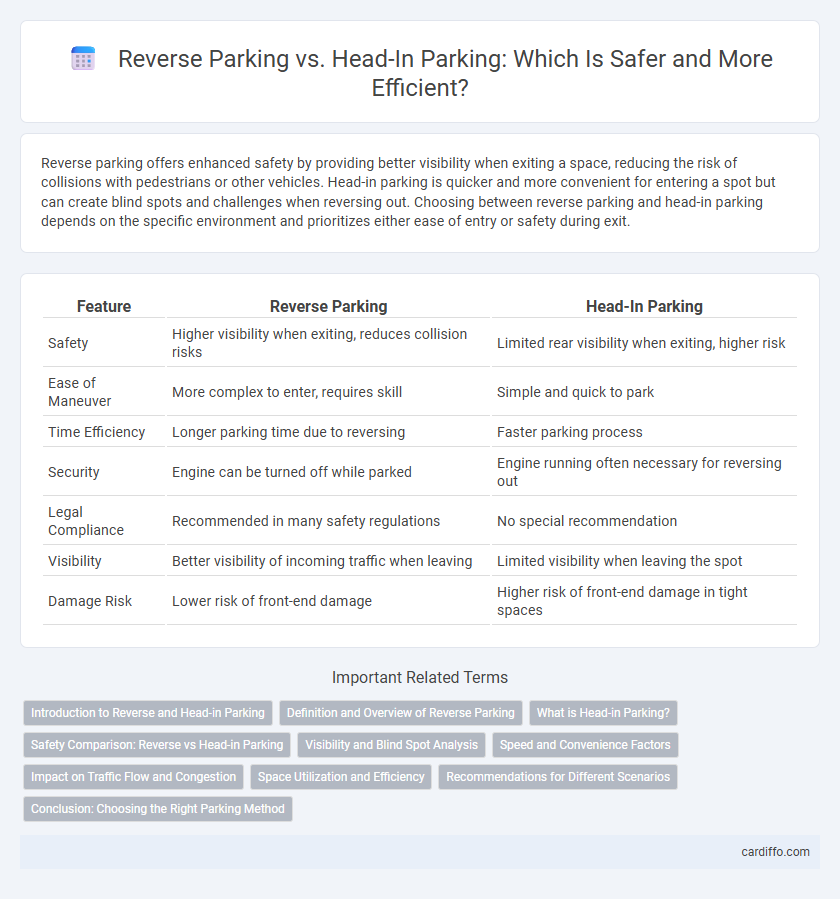Reverse parking offers enhanced safety by providing better visibility when exiting a space, reducing the risk of collisions with pedestrians or other vehicles. Head-in parking is quicker and more convenient for entering a spot but can create blind spots and challenges when reversing out. Choosing between reverse parking and head-in parking depends on the specific environment and prioritizes either ease of entry or safety during exit.
Table of Comparison
| Feature | Reverse Parking | Head-In Parking |
|---|---|---|
| Safety | Higher visibility when exiting, reduces collision risks | Limited rear visibility when exiting, higher risk |
| Ease of Maneuver | More complex to enter, requires skill | Simple and quick to park |
| Time Efficiency | Longer parking time due to reversing | Faster parking process |
| Security | Engine can be turned off while parked | Engine running often necessary for reversing out |
| Legal Compliance | Recommended in many safety regulations | No special recommendation |
| Visibility | Better visibility of incoming traffic when leaving | Limited visibility when leaving the spot |
| Damage Risk | Lower risk of front-end damage | Higher risk of front-end damage in tight spaces |
Introduction to Reverse and Head-in Parking
Reverse parking involves maneuvering a vehicle backward into a parking space, offering better visibility and easier exit in tight spots, while head-in parking requires driving forward into the space. Reverse parking enhances safety by reducing blind spots and providing greater control when leaving the spot, especially in crowded areas. Head-in parking, although simpler for novice drivers, may increase the risk of collisions when reversing out, as rear visibility is limited without assistive technology.
Definition and Overview of Reverse Parking
Reverse parking, also known as backing-in parking, involves maneuvering a vehicle into a parking space by reversing the car's position. This technique offers enhanced visibility when exiting the space, improving safety by allowing drivers to see oncoming traffic more clearly. In contrast, head-in parking requires front-first entry, which can limit rear visibility and increase the risk when leaving the spot.
What is Head-in Parking?
Head-in parking involves maneuvering a vehicle front-first into a parking space, allowing the driver to park quickly and easily. This method provides better visibility when entering a spot and reduces the need for reversing, enhancing safety in busy parking lots. Head-in parking also ensures easier access to the vehicle's rear, which is beneficial for loading and unloading cargo or passengers.
Safety Comparison: Reverse vs Head-in Parking
Reverse parking enhances safety by providing better visibility of pedestrians and obstacles when exiting a space, reducing the risk of collisions. Head-in parking limits the driver's view when pulling out, increasing the chance of accidents with oncoming traffic or pedestrians. Studies show that reverse parking decreases backing crash incidents by up to 40%, making it a safer option in most parking environments.
Visibility and Blind Spot Analysis
Reverse parking offers enhanced visibility for drivers by allowing a clear view of the parking space and surrounding obstacles through the rearview and side mirrors, reducing blind spots during maneuvering. Head-in parking limits visibility when exiting the space, increasing the risk of blind spot incidents due to restricted forward sightlines and the need to reverse into traffic. Implementing sensor technology and advanced camera systems can mitigate blind spots in both parking methods, improving overall safety and situational awareness.
Speed and Convenience Factors
Reverse parking often provides enhanced safety and precision, allowing drivers to maneuver into tight spaces more accurately and exit more easily, despite taking slightly longer to execute than head-in parking. Head-in parking typically offers quicker entry and exit for drivers, ideal for short stops or high-traffic areas where speed is crucial. The choice between reverse and head-in parking depends on balancing time efficiency with ease of vehicle departure and overall spatial constraints.
Impact on Traffic Flow and Congestion
Reverse parking enhances traffic flow by allowing vehicles to exit spaces with a clear view of oncoming traffic, reducing delays and congestion during departure. Head-in parking often causes longer waiting times as drivers must back out blindly, increasing the risk of accidents and traffic bottlenecks. Efficient use of reverse parking can significantly improve overall traffic movement in busy parking areas, minimizing congestion on adjacent roadways.
Space Utilization and Efficiency
Reverse parking maximizes space utilization by allowing vehicles to fit more precisely within marked spaces, reducing the chance of overhang and enabling tighter rows in parking lots. This method enhances efficiency during departure since drivers can exit spots forward, improving visibility and safety. In contrast, head-in parking often results in less optimal space usage due to inconsistent vehicle alignment and wider clearance requirements for opening doors.
Recommendations for Different Scenarios
Reverse parking offers better visibility and safer maneuvering in tight spots, making it ideal for congested urban areas or narrow parking lots. Head-in parking suits locations with ample space and low traffic, allowing quicker exits and easier access to the vehicle's rear. For high-traffic or poorly lit areas, reverse parking is recommended due to enhanced control and reduced risk of collisions.
Conclusion: Choosing the Right Parking Method
Reverse parking offers enhanced safety by improving driver visibility when exiting, reducing the risk of collisions in busy parking lots. Head-in parking is quicker and simpler, ideal for short stops where convenience outweighs safety concerns. Selecting the best parking method depends on the specific environment, driver skill level, and priority of safety versus speed.
Reverse parking vs head-in parking Infographic

 cardiffo.com
cardiffo.com